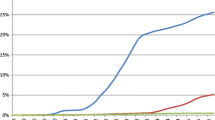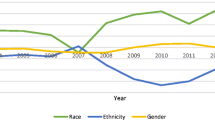Abstract
This study examines mortgage market implications of the opioid public health crisis in the United States. Employing data on over 4 million mortgage loan application records, we find lenders are less likely to approve loans from areas with relatively higher levels of opioid abuse significantly impeding borrowers’ access to financial markets. Consistent with risk channeling, originated mortgage loans are more likely to have lower loan-to-income ratios in areas with higher rates of opioid abuse. Heterogeneity among lender firms also affects the extent to which lenders incorporate concerns about risks induced by the opioid crisis into loan underwriting, with traditional lenders located in the county where the purchased residential property is located being most likely to base loan approval decisions on the perceived severity of the local opioid epidemic. The U.S. Drug Enforcement Administration’s tightening controls of hydrocodone products serves as a quasi-natural experiment and supports a causal interpretation suggesting opioid abuse is an additional risk factor that is likely to affect mortgage lending decisions on the extensive margin.



Similar content being viewed by others
Notes
This statistic is based on the number of drug overdose deaths between 1999 and 2018 as reported by the CDC. See, https://www.cdc.gov/drugoverdose/epidemic/index.html.
Similarly, Hsu et al. (2017) find that prescription opioid overdose-associated admissions contribute to an increase in hospitalization costs with more than $700 million annually.
Note that this is only a middle estimate as we find stronger results using alternative specifications.
Demirguc-Kunt and Huizinga (2010) suggest that banking strategies that rely prominently on generating noninterest income are risky. Therefore, it is also possible that nontraditional banks choose to ignore the potential health risk in their lending processes.
The CDC Wonder gathers and provides the Multiple Cause of Death data from the National Center for Injury Prevention and Control (NCIPC) where deaths are classified by the International Classification of Diseases, 10th Revision (ICD-10). See, https://www.cdc.gov/drugoverdose/data/statedeaths/drug-overdose-death-2018.html and http://wonder.cdc.gov/mcd-icd10.html.
See, www.cdc.gov/drugoverdose/maps/rxrate-maps.html. The CDC website collects the data from the IQVIA Transactional Data Warehouse (TDW) for 2006 to 2017. Opioid prescriptions include buprenorphine, codeine, fentanyl, hydrocodone, hydromorphone, methadone, morphine, oxycodone, oxymorphone, propoxyphene, tapentadol, and tramadol.
HMDA was enacted by Congress in 1975 and expanded in 1988, aiming to inform the public about the efficacy of financial institutions serving local credit needs.
Zillow Home Value Index (ZHVI) is a smoothed, seasonally adjusted measure of the typical home value and market changes across a given region and housing type. For details, see https://www.zillow.com/research/data/.
Moreover, the second wave of the opioid epidemic started from 2010 per the CDC.
The regression sample effectively consists of applications with complete information on all key personal information such as income, loan amount, gender, and race.
Since the average loan amount of a loan application is $315650 and the average number of loan applications in each year is roughly 513480, the yearly aggregate amount is $315650*513480=$162079962000. On average, the mortality rate is 19.67. The baseline model suggests that the probability of loan approval should have increased by 0.0005*19.67=0.009835 if the opioid crisis had not happened. Thus, $162079962000*0.009835=$1594058367 worth of loans should have been originated in a year.
See, for example, Table 2 in Chu and Qiu (2021)
Recent studies show that loan officers use “soft” information in loan origination processes (Drexler and Schoar , 2014).
The Controlled Substances (CSA) places substances with accepted medical uses into one of four schedules, with the substances with the highest potential for harm and abuse being placed in Schedule II, and substances with progressively less potential for harm and abuse being placed in Schedules III through V. Schedule I is reserved for those controlled substances with no currently accepted medical use and lack of accepted safety for use.
For a more detailed review of the recent studies on the effects of hydrocodone rescheduling, see Usmani et al. (2020).
The degree of enforcement of these laws and policies also varies. For example, although almost all states have Prescription Drug-Monitoring Programs, the specific provisions with regard to inter-state data sharing, enrollment, access mandates, law enforcement access, and data collection interval differ from states to states.
Values are rescaled to range from 0 to 100.
The inclusion of county fixed effects completely absorb the impact of Exposure in addition to any other time-invariant unobserved heterogeneity across different regions. For similar reasons, we omit Post due to the inclusion of year fixed effects.
Since the treatment effects are state-specific, we follow Bertrand and Mullainathan (2003) and allow for clustering at the state level. Alternative correction methods do not substantially affect our conclusions.
The sample period selection is similar to that in columns (1)-(4).
Therefore, we omit the interaction term for that year (Before\(^{-1}\) \(\times\) Exposure) in our regressions to avoid collinearity.
In particular, for banks reporting to Office of the Comptroller of the Currency (OCC, agency code equal to 1), we match the respondent ID in HMDA to RSSD9055 in the Call Report; for banks reporting to the Federal Reserve (agency code equal to 2), we match the respondent ID in HMDA to RSSD9001 in the Call Report; and for banks reporting to the Federal Deposit Insurance Corporation (FDIC, agency code equal to 3), we match the respondent ID in HMDA to RSSD9050 in the Call Report.
In addition, interpreting the marginal effects in a conditional probability framework is non-intuitive and problematic.
We acknowledge the limitation that this measure tends to underestimate eventual loan sales.
References
Ai, C., & Norton, E. C. (2003). Interaction terms in logit and probit models. Economics Letters, 80, 123–129.
Akins, B., Li, L., Ng, J., & Rusticus, T. O. (2016). Bank competition and financial stability: Evidence from the financial crisis. Journal of Financial and Quantitative Analysis, 51, 1–28.
Almeida, H., Huang, R., Liu, P., & Xuan, Y. (2021). How Does Health Insurance Affect Firm Employment and Performance? Evidence from Obamacare. Working Paper.
Bertrand, M., & Mullainathan, S. (2003). Enjoying the quiet life? corporate governance and managerial preferences. Journal of Political Economy, 111, 1043–1075.
Campbell, J. Y., & Cocco, J. F. (2015). A model of mortgage default. The Journal of Finance, 70, 1495–1554.
Chu, Y., & Qiu, M. (2021). Debt incentives and bank risk-taking. Real Estate Economics, 49, 778–808.
Chumpitazi, C. E., Rees, C. A., Camp, E. A., & Bernhardt, M. B. (2017). Decreased opioid prescribing in a pediatric emergency department after the rescheduling of hydrocodone. The Journal of Emergency Medicine, 52, 547–553.
Cornaggiay, K., Hundz, J., Nguyenx, G., & Ye, Z. (2020). Opioid Crisis Effects On Municipal Finance. Working Paper.
Currie, J., & Schwandt, H. (2020). The Opioid Epidemic Was Not Caused by Economic Distress But by Factors that Could be More Rapidly Addressed. Working Paper 27544 National Bureau of Economic Research.
Currie, J., & Tekin, E. (2015). Is there a link between foreclosure and health? American Economic Journal: Economic Policy, 7, 63–94.
Curtis, Q. (2014). State foreclosure laws and mortgage origination in the subprime. J Real Estate Finan Econ, 49, 303–328.
Davis, L. W. (2004). The effect of health risk on housing values: Evidence from a cancer cluster. American Economic Review, 94, 1693–1704.
Demirguc-Kunt, A., & Huizinga, H. (2010). Bank activity and funding strategies: The impact on risk and returns. Journal of Financial Economics, 98, 626–650.
D’Lima, W., & Thibodeau, M. (2019). Opioid Crisis and Housing Market Externalities. Working Paper.
Drexler, A., & Schoar, A. (2014). Do relationships matter? evidence from loan officer turnover. Management Science, 60, 2722–2736.
Duchin, R., & Sosyura, D. (2014). Safer ratios, riskier portfolios: Banks? response to government aid. Journal of Financial Economics, 113, 1–28.
Florence, C., Luo, F., Xu, L., & Zhou, C. (2016). The economic burden of prescription opioid overdose, abuse and dependence in the united states, 2013. Med Care, 54, 901–906.
Gao, H., Hsu, P.-H., Li, K., & Zhang, J. (2020). The real effect of smoking bans: Evidence from corporate innovation. Journal of Financial and Quantitative Analysis, 55, 387–427.
Greene, W. (2004). The behaviour of the maximum likelihood estimator of limited dependent variable models in the presence of fixed effects. The Econometrics Journal, 7, 98–119.
Hsu, D. J., McCarthy, E. P., Stevens, J. P., & Mukamal, K. J. (2017). Hospitalizations, costs and outcomes associated with heroin and prescription opioid overdoses in the united states 2001–12. Addiction, 112, 1558–1564.
Jansen, M. (2022). Spillover effects of the opioid epidemic on consumer finance. Journal of Financial and Quantitative Analysis, . forthcoming.
Kirson, N. Y., Scarpati, L. M., Enloe, C. J., Dincer, A. P., Birnbaum, H. G., & Mayne, T. J. (2017). The economic burden of opioid abuse: Updated findings. Journal of Managed Care & Specialty Pharmacy, 23, 427–445. PMID: 28345440.
Lancaster, T. (2000). The incidental parameter problem since 1948. Journal of Econometrics, 95, 391–413.
Li, W., & Zhu, Q. (2019). The Opioid Epidemic and Local Public Financing: Evidence from Municipal Bonds. Working Paper.
Meara, E., Horwitz, J. R., Powell, W., McClelland, L., Zhou, W., O’Malley, A. J., & Morden, N. E. (2016). State legal restrictions and prescription-opioid use among disabled adults. New England Journal of Medicine, 375, 44–53. PMID: 27332619.
Munnell, A. H., Tootell, G. M. B., Browne, L. E., & McEneaney, J. (1996). Mortgage lending in boston: Interpreting hmda data. The American Economic Review, 86, 25–53.
Oehler, E. C., Day, R. L., Robinson, D. B., & Brown, L. H. (2016). Has the rescheduling of hydrocodone changed ed prescribing practices? The American Journal of Emergency Medicine, 34, 2388 – 2391.
Ouimet, P., Simintzi, E., & Ye, K. (2020). The Impact of the Opioid Crisis on Firm Value and Investment. Working Paper.
Palacios, J., Eichholtz, P., Kok, N., & Aydin, E. (2020). The impact of housing conditions on health outcomes. Real Estate Economics, n/a, 1–29.
Patrick, S. W., Fry, C. E., Jones, T. F., & Buntin, M. B. (2016). Implementation of prescription drug monitoring programs associated with reductions in opioid-related death rates. Health Affairs, 35, 1324–1332. PMID: 27335101.
Paulozzi, L. J., Mack, K. A., & Hockenberry, J. M. (2014). Vital Signs: Variation Among States in Prescribing of Opioid Pain Relievers and Benzodiazepines - United States, 2012. Morbidity and Mortality Weekly Report, 63, 563–568.
Raji, M. A., Kuo, Y.-F., Adhikari, D., Baillargeon, J., & Goodwin, J. S. (2018). Decline in opioid prescribing after federal rescheduling of hydrocodone products. Pharmacoepidemiology and Drug Safety, 27, 513–519.
Ruhm, C. J. (2019). Drivers of the fatal drug epidemic. Journal of Health Economics, 64, 25–42.
Smolen, G., Moore, G., & Conway, L. (1992). Economic effects of hazardous chemical and proposed radioactive waste landfills on surrounding real estate values. Journal of Real Estate Research, 7, 283–295.
Usmani, S. A., Hollmann, J., Goodin, A., Hincapie-Castillo, J. M., Adkins, L. E., Ourhaan, N., Oueini, R., Bhagwandass, H., Easey, T., & Vouri, S. M. (2020). Effects of hydrocodone rescheduling on opioid use outcomes: A systematic review. Journal of the American Pharmacists Association, .
Acknowledgements
We would like to thank seminar participants at the AREUEA-NATL Conference 2021, the 37th Annual ARES Meeting, Florida International University, The University of Texas at El Paso, and the University of Alabama for helpful comments and suggestions.
Author information
Authors and Affiliations
Corresponding author
Appendix
Appendix
Rights and permissions
Springer Nature or its licensor (e.g. a society or other partner) holds exclusive rights to this article under a publishing agreement with the author(s) or other rightsholder(s); author self-archiving of the accepted manuscript version of this article is solely governed by the terms of such publishing agreement and applicable law.
About this article
Cite this article
Luo, S.(., Tidwell, A. Hidden Financial Costs of the Opioid Crisis: Evidence from Mortgage Originations. J Real Estate Finan Econ (2023). https://doi.org/10.1007/s11146-023-09946-z
Accepted:
Published:
DOI: https://doi.org/10.1007/s11146-023-09946-z




